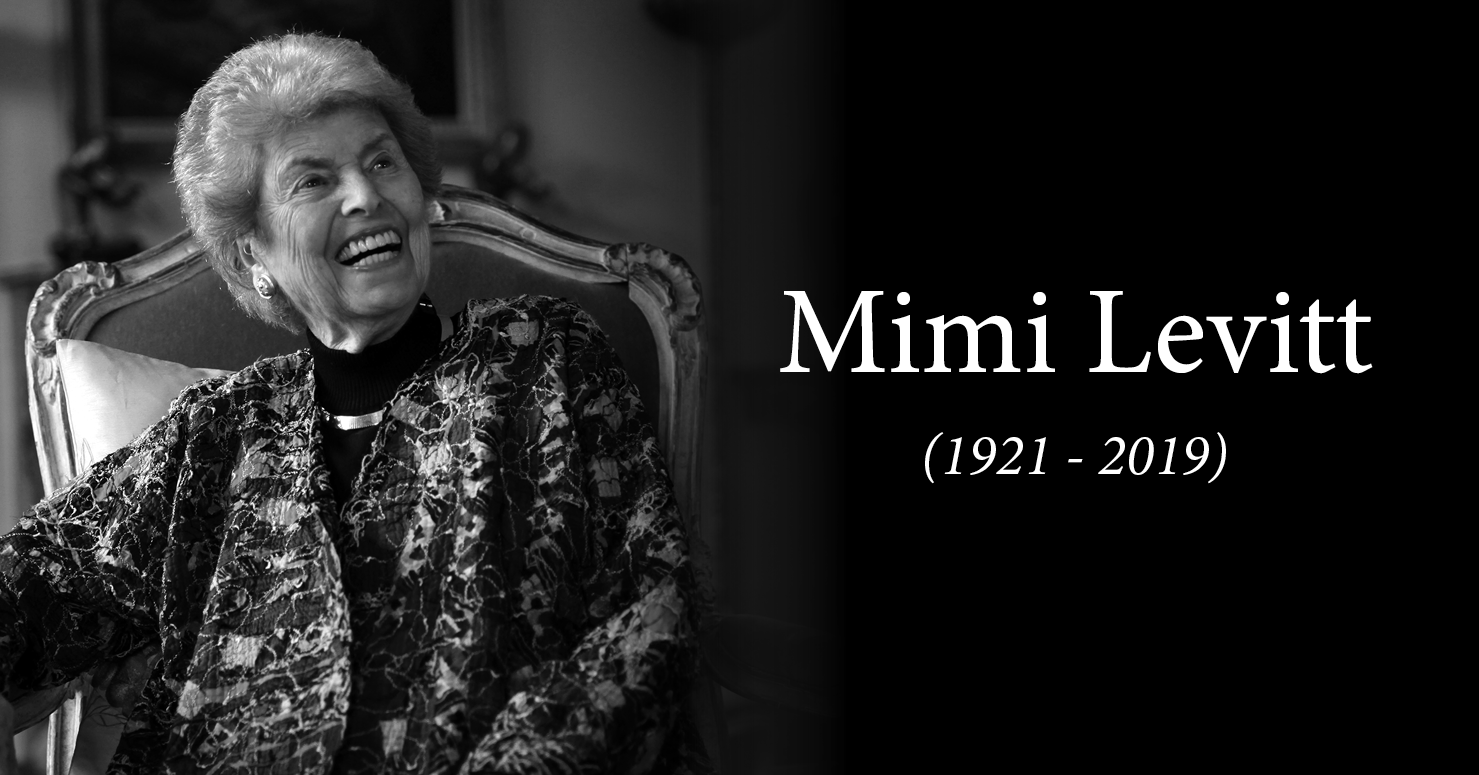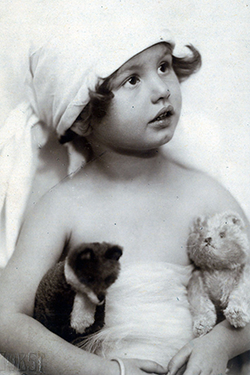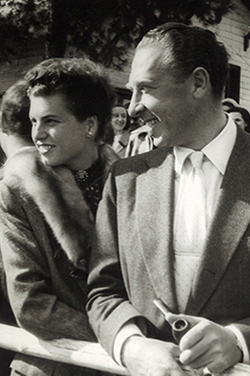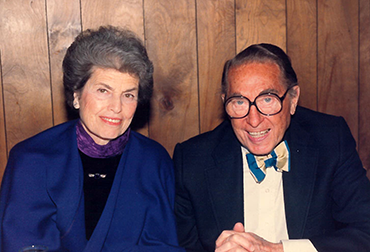
Mimi Levitt (1921–2019)
An iconic patron of the arts and historic preservation, Annemarie “Mimi” Gratzinger Levitt was best known for her intelligence, grace and hands-on approach to philanthropy and activism. She believed in the arts as a source for positive social change and left a lasting legacy of generosity and service to the causes she supported. In 1966, Mimi and her husband Mortimer established the Mortimer Levitt Foundation to support the arts, culture and education, which was later renamed the Mortimer & Mimi Levitt Foundation in 2012 in honor of her contributions.
Early years and meeting Mortimer
 Born in Vienna, Austria, in 1921, the daughter of a prominent dentist, Mimi’s childhood was filled with opera and other musical experiences. Her parents later divorced and she emigrated to the United States with her mother at the outbreak of World War II, and soon after attended Pomona College in California, where she graduated Phi Beta Kappa with a degree in French Literature. A linguist fluent in five languages, she was one of the translators at the Nuremberg trials in the late 1940s. In 1947, Mimi accepted a position as senior assistant to Alfred Barr, Jr., the first director of the Museum of Modern Art in New York.
Born in Vienna, Austria, in 1921, the daughter of a prominent dentist, Mimi’s childhood was filled with opera and other musical experiences. Her parents later divorced and she emigrated to the United States with her mother at the outbreak of World War II, and soon after attended Pomona College in California, where she graduated Phi Beta Kappa with a degree in French Literature. A linguist fluent in five languages, she was one of the translators at the Nuremberg trials in the late 1940s. In 1947, Mimi accepted a position as senior assistant to Alfred Barr, Jr., the first director of the Museum of Modern Art in New York.
Mimi met Mortimer Levitt at a Manhattan art gallery opening, where they had a spirited debate over a painting (Mimi favored abstraction; Mortimer preferred realism). Following a brief courtship, they married on June 18, 1948, and together became philanthropists supporting youth music programs, performing arts organizations and educational institutions. Mimi and Mortimer were known for promoting aspiring young musicians by hosting salons at their Manhattan brownstone. An imaginative and meticulous hostess, Mimi was also known to throw memorable charity events and family celebrations, and she often opened the Levitt family home to artists and musicians.
“Champion of the Arts”
 As summer residents of Westport, Connecticut, the Levitts were approached by community and civic leaders in the early 1970s to support a local effort to build an outdoor music venue that would transform the town dump into a gathering place in the heart of town. As the campaign’s largest private contributors, the Levitts were nevertheless surprised when the town named its new pavilion after them upon opening in 1974: The Levitt Pavilion for the Performing Arts. Mimi served on the Levitt Pavilion board for decades, helping the nonprofit flourish and become a community treasure. “She had a real impact on the performing arts in Westport…It always inspired me to see her attending the performances because I knew she was there because of her love of music, her love of Westport, and her desire to be a part of our community,” said Jim Marpe, a local Westport official in a 2019 Westport News article.
As summer residents of Westport, Connecticut, the Levitts were approached by community and civic leaders in the early 1970s to support a local effort to build an outdoor music venue that would transform the town dump into a gathering place in the heart of town. As the campaign’s largest private contributors, the Levitts were nevertheless surprised when the town named its new pavilion after them upon opening in 1974: The Levitt Pavilion for the Performing Arts. Mimi served on the Levitt Pavilion board for decades, helping the nonprofit flourish and become a community treasure. “She had a real impact on the performing arts in Westport…It always inspired me to see her attending the performances because I knew she was there because of her love of music, her love of Westport, and her desire to be a part of our community,” said Jim Marpe, a local Westport official in a 2019 Westport News article.
By the late 1990s, the ongoing success of the Westport pavilion inspired the idea for the Levitts to support Levitt music venues across the country. Following her husband’s passing in 2005, Mimi became board president of the Levitt Foundation and supported the growth of the Levitt program nationwide, while remaining committed that the original pavilion continued to thrive. In 2006, Mimi was honored by Levitt Pavilion Westport with the Annual SuperStar Award. In 2011, she was honored at the Westport Arts Awards as a “Champion of the Arts.” Family friend Louise Kerz Hirschfeld remarked at her memorial, “The network of Levitt music venues that bring joy to people across the country is a beautiful testament to Mimi’s generous spirit of love and music.”
An active and loyal benefactor of the Bard Music Festival, Mimi served on the board of directors for 15 years (1998–2013), and for many years underwrote the Festival’s annual opening night dinner. An avid lover of opera, she supported opera workshops in the Conservatory’s Vocal Arts Program directed by acclaimed soprano Dawn Upshaw and helped commission one act operas. Mimi also funded scholarships for Conservatory students and started the first endowment for the Bard Music Festival in 2005. In 2006, Mimi received the Charles Flint Kellogg Award in Arts and Letters in recognition for her longstanding support of the Festival.
“A great activist” and “thoughtful philanthropist”
 Mimi was also passionately committed to historic preservation; in the 1970s she spearheaded the Neighborhood Association to Preserve Fifth Avenue Houses that successfully championed the creation of the Metropolitan Museum Historic District in New York City, designated in 1977. Her involvement grew from concern about protecting the distinctive character of her Upper East Side neighborhood, which in the 1970s was undergoing significant change. Mimi also served on the board of the Friends of the Upper East Side Historic District.
Mimi was also passionately committed to historic preservation; in the 1970s she spearheaded the Neighborhood Association to Preserve Fifth Avenue Houses that successfully championed the creation of the Metropolitan Museum Historic District in New York City, designated in 1977. Her involvement grew from concern about protecting the distinctive character of her Upper East Side neighborhood, which in the 1970s was undergoing significant change. Mimi also served on the board of the Friends of the Upper East Side Historic District.
As was one of the earliest supporters of the New York Landmarks Conservancy, Mimi served on its board from 1978–2014. In addition to being a generous patron to the Conservancy’s endowment and annual Living Landmarks gala, Mimi was an effective fundraiserconnecting people to the cause. “She was a great activist and thoughtful philanthropist,” said Scott Leurquin of the New York Landmarks Conservancy. “She wrote numerous letters asking friends and acquaintances for donations, made fundraising calls, paid for committee lunches and underwrote table arrangements for several of our galas.” As a Conservancy board member, she even wrote a poem dedicated to famed architect and then board chair John Belle, which was read at his memorial service. Mimi was honored by the Conservancy in 2011 for her 30 years of service.
In 1995, reflecting her love of natural habitats and preservation, Mimi along with Mortimer donated 564 acres of wildlife habitat near Half Moon Bay in San Mateo County, California to the Peninsula Open Space Trust—at that time, the second-largest gift in the county’s history—providing an invaluable boost to ecological conservation efforts dedicated to preserving the beauty and character of the region’s natural resources.
 Together with Mortimer, Mimi also supported the Metropolitan Opera, Lincoln Center for the Performing Arts, Mercy College, Museum of Television and Radio, New York City Opera, The Metropolitan Museum of Art, Central Park Conservancy, The Joyce Theater, New Victory Theater, Lincoln Center’s Film Society, Hunter College, The Music Center of Los Angeles, School of American Ballet, American Red Cross and Young Concert Artists. She was a member of the Mayor’s Commission on Drug Addiction under Mayor Koch, a former trustee of the Town School in Manhattan and the Branch Libraries of the New York Public Library. She also was a children’s literacy volunteer in Harlem. Butzi Moffitt, a dear friend for many decades shared at her memorial, “Mimi was one of the most generous, positive, and thoughtful individuals I have ever known. She was beautiful inside and out.”
Together with Mortimer, Mimi also supported the Metropolitan Opera, Lincoln Center for the Performing Arts, Mercy College, Museum of Television and Radio, New York City Opera, The Metropolitan Museum of Art, Central Park Conservancy, The Joyce Theater, New Victory Theater, Lincoln Center’s Film Society, Hunter College, The Music Center of Los Angeles, School of American Ballet, American Red Cross and Young Concert Artists. She was a member of the Mayor’s Commission on Drug Addiction under Mayor Koch, a former trustee of the Town School in Manhattan and the Branch Libraries of the New York Public Library. She also was a children’s literacy volunteer in Harlem. Butzi Moffitt, a dear friend for many decades shared at her memorial, “Mimi was one of the most generous, positive, and thoughtful individuals I have ever known. She was beautiful inside and out.”
Mimi was a beloved mother, aunt, step-grandmother and step-great-grandmother, who cherished her family and the time they spent together. “When I think of all the people whose lives have been enriched by my mother’s thoughtfulness and generosity, my heart bursts with pride,” said daughter Liz Levitt Hirsch, who remembered her as a “master locksmith, able to unlock doors to give people opportunities.”

We are so grateful for this visionary lady who understood the power of Art and showed how individuals can truly make a huge impact.
Third year recipient with our partners at the City of Ocala, Florida of a Levitt AMP Music Series grant. #creativeplacemaking
#musicmoves
We are praying your strength and comfort during your time of bereavement. We speak her name in our prayers and thank God for her life and legacy.
Though I am terribly saddened to learn of the passing of Mimi Levitt ,
I join in celebrating her life dedication to the arts, to historic preservation, to the preservation of natural habitat, her dedication to her family.
The wise and generous legacy of Mimi Levitt will continue to enrich lives as well institutions for present and future generations .
It was a privilege,and an inspiring gift to know her just briefly.
I send heartfelt sympathy to the Levitt family .
Mimi,
You smile, grace and elegance will always be in my heart. The way you welcomed me into your home and gave me advice while starting my career will always be remembered. You were an inspiration to me, and will be missed. My heartfelt condolences to Liz and Peter.
I am deeply saddened that Mimi Levitt is no longer with us to share her vision and her humanity. It is an honor to have known her and to have heard her incredible story, a truly great American story. Mimi leaves a legacy of changed communities and changed lives, a legacy that will live on for generations to come. Thank you. With deepest respect and sympathy for the entire Levitt family.
Jeff Parks
Bethlehem, PA
We were introduced to the deeply arresting weekly dinners at the Levitt household though mutual friend, Bill Bernbach, one of America’s most gifted advertising men (“You don’t have to be Jewish to enjoy Levi’s Rye Bread!)” acclaimed an Asian fellow from a subway poster!!) Our Levitt friendship continued for decades!
Mimi’s youthful work, translating at Nuremberg was an historic, singular accomplishment. At home in Manhattan, Mimi’s attention inspired effective preservation work in her very neighborhood. The Levitt’s wide fiscal support aided many classical musicians under the aegis of Young Concert Artists. The two underwrote my documentary “Great Berkshire Gardens,” enabling the film’s broadcasting on PBS-TV. Such friends are among life’s true blessings.
Dear Liz
I am so sad to hear about passing of
your beloved Mom. My thoughts and
prayers are with you! Sending my Love and Deepest Condolences to you and Family.
What a grand lady & visionary, and thanks to love of the arts, she made it possible for many of us in Chattanooga, Tn. to have a wonderful time for many weeks to have free music to enjoy. Sending the family prayers & sympathy in the next coming days.
The Levitt foundation has graced our city, enriched a small, local, emerging arts organization. Thanks and gratitude from Carson City to the generous spirit of the Levitt’s.
What a beautiful life and a beautiful gift Mimi has given to us through her vision, dedication and passion. My deepest condolences to her family. In gratitude, we celebrate her gift through the Levitt AMP Ocala Music Series for a 3rd year.
Dear Levitt family, we are sorry to hear of the loss of your mother, Mimi. Having just read of her life, her vision, the generosity of Mimi & Mortimer, and all she continued doing to support music and the arts across America makes me say “Wow- What a lady! Such energy and devotion!” May her spirit continue through the many artists and the Arts she supported. Our little town of Middlesboro, Kentucky has certainly benefited. Most sincerely,
Mimi – you will be in my heart forever – thank you
The visionary life work of Mimi Levitt will continue to be a well-spring of inspiration for the creative placemaking movement. Her legacy touches us deeply. My sincere condolences to her family and all who knew and loved her.
What a beautiful life! Love our Carson City series of concerts and can’t thank this couple enough for supporting the arts.
Love,
Russ
So sad to hear of Mimi’s passing. Levitt Amp Galva is just now in its second year with the Levitt Amp Grant and getting to know about the great organization, and the people (Mortimer & Mimi) who have touched so many lives. People like Mimi are not easily replaced. Our Sympathies to the family and those that knew her.
Dear Liz,
My condolences for your profound loss. What an amazing woman! She certainly lived a full life and gave so much of herself to the arts and to preservation. No doubt she has been an inspiration to countless people.. You certainly take after her, Liz. How blessed are both of you to have had each other for so many years.
With love,
Julie
I’m sitting here crying and didn’t know her. The Denver pavilion is a mile from my house and I couldn’t be more grateful.
I suppose my sadness is she’s no longer with us, and I’ll never rise to her level.
<3
Mimi’s genius for creating communities around the art and music that she loved was a rare gift. Along with Mortimer she turned cultural passions into generous opportunities for both artists and audiences. Mimi’s Old World grace and wit lit up a room, and if you were among those who sat at her dining room table like family, you counted yourself lucky. Her passing leaves a vast hole in our lives, but it’s a space rich with experience shared over many years in company with this deft, insightful woman.
One of the most beautiful people I’ve had the pleasure of working and serving
It is so inspiring to read about this strong and loving woman’s life. Liz, thank you for sharing the abundant details of your amazing Mother’s life. For sure her legacy will not be forgotten. I also send much Peace and Serenity to You and all your family at this time of your Mother’s passing. Your own life’s accomplishments are already an inspiring extension of what your loving Mother began !
As a family friend of over 33 years, I saw the love and respect, Liz and her mother Mimi shared. Mimi was always there to support Liz, and Liz in turn was a wonderful daughter. Mimi was very much Liz’ inspiration and shaped Liz into the amazing human being, she is today. And I have many fond memories, of the kindness of Mimi. I send the Levitt family, my heartfelt condolences with love….x
A magnificent life dedicated to the power of music and visual arts, to dance and theater, to beauty and familial love. Mimi was a tender friend to the Javits family. I loved her warm hugs, lively voice, probing questions and wondrous smile!
Warm regards, to you Liz and Peter,
Joy
I am deeply saddened by the loss of an amazing and beautiful lady…Mimi Levitt. I had the great honor and pleasure of spending time with her both in California and New York. I listened to her wonderful stories about her incredible life and I was truly inspired. I will miss her zest for life, love of music but I will miss her smile that could light up a room. Mimi will always be remembered and loved by all who met her.
Beautiful Viv. Thank you for capturing her wonderful spirit.
Thank you for sharing this. You are truly carrying forward your mother’s tradition of supporting the arts that serve our communities.
Sorry for your loss!
Liz, Thank you for passing along this great story of lifelong service to others, AND to you for carrying her tradition forward.
A great woman whose legacy lives on in her illustrious daughter, who is my good friend. She clearly had an indelible impact on the cultural institutions and causes she so generously supported. I am honored personally that she attended a talk I gave at the Museum of Modern Art where (I now learn) she was assistant to Alfred Barr in 1947. Our world is lucky to have had Mimi Levitt.
May her memory be a blessing,
Debra Levine
Los Angeles